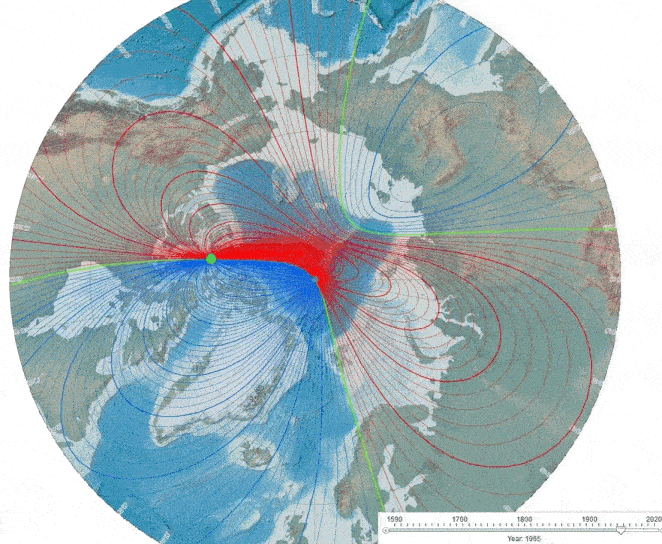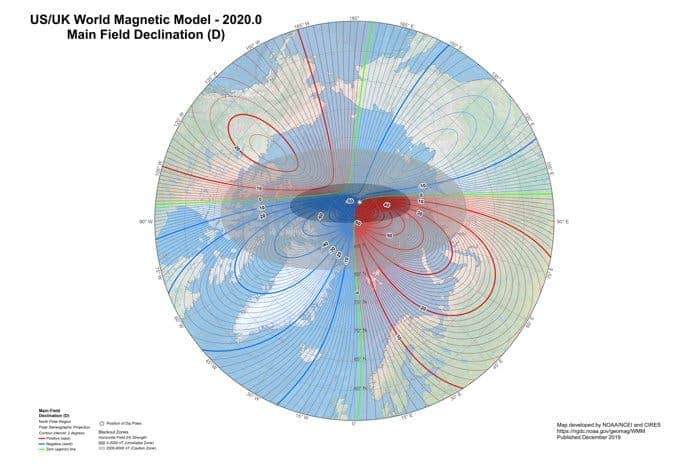Unlike the geographical poles, the planet’s magnetic poles are in constant motion, following the flow of Earth’s molten iron outer core, which moves and flows as the planet spins. That’s common knowledge for centuries now. In fact, sometimes the magnetic poles will even flip every couple hundred thousand years or so. What’s surprising, however, is the high rate at which the magnetic north pole is drifting toward the East, from the Canadian Arctic towards Russia.

The planet’s outer core is composed of liquid iron which constantly moves as the planet’s interior gradually cools down. This motion creates electric currents as electrons move through the liquid and, in the process, the energy of the fluid is converted into a magnetic field. If we imagined that Earth’s magnetic field is similar to a bar magnet (or dipole), then we can locate a geomagnetic north and south pole. However, this is an oversimplification of the complexity and variation of Earth’s true magnetic field.
In the last couple of decades, scientists have noticed that the northern magnetic pole has been shifting away from the Canadian Arctic toward Siberia at an average rate of 55 kilometers (34 miles) per year. Most recently, it has slowed down to 40 kilometers (25 miles) per year, which is still significantly higher than the average recorded over the last century.
To keep up with the north magnetic pole’s motions, scientists have established the World Magnetic Model (WMM) in order to enable systems to provide accurate navigation and positioning.
The WMM is used by all sorts of applications from smartphones to the military. But although the WMM is also incorporated by things like Google Maps, regular folks shouldn’t worry too much since the north magnetic pole’s movements aren’t all that important for latitudes below 55 degrees.
The WMM is updated every five years, but researchers at the National Centers for Environmental Information — a collaboration between NOAA and the British Geological Survey — decided to hit the update button a year earlier in order to account for the faster than anticipated drifting of the north magnetic pole.

This week, 2020 World Magnetic Model was officially released, which forecasts where the magnetic pole is headed for the next 5 years until the next update. At the moment, researchers claim that the north magnetic pole has now officially crossed the prime meridian.
“Based on the WMM2020 coefficients for 2020.0 the geomagnetic north pole is at 72.68°W longitude and 80.65°N latitude, and the geomagnetic south pole is at 107.32°E longitude and 80.65°S latitude. The axis of the dipole is currently inclined at 9.41° to the Earth’s rotation axis. The WMM can also be used to calculate dip pole positions. These model dip poles are computed from all the Gauss coefficients using an iterative method. In 2020.0 the north dip pole computed from WMM2020 is located at longitude 164.04°E and latitude 86.50°N and the south dip pole at longitude 135.88°E and latitude 64.07°S,” NOAA researchers wrote.
Over the last 150 years, the magnetic pole has crept north over 1,000 kilometers. It’s not clear why this acceleration is occurring due to gaps in our knowledge of how the planet’s core behaves. One leading hypothesis suggests that liquid molten iron under Canada is being dragged toward Siberia. In the meantime, the magnetic South Pole has barely moved, which is another mystery.









